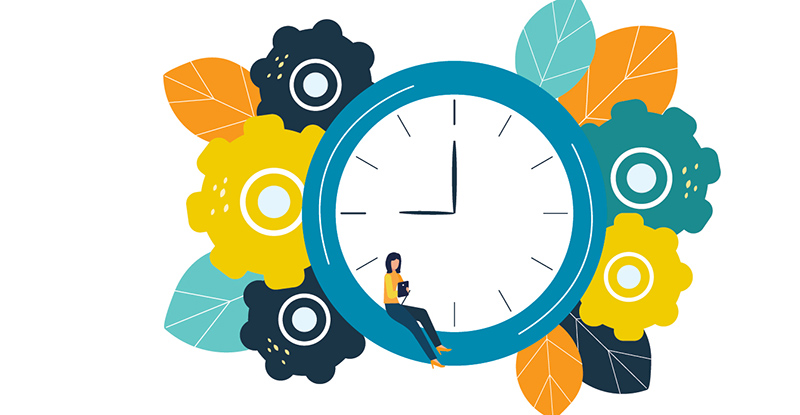
Ann Gomez is a recurring instructor for the CPABC PD Program, and two of her webinars—“The Prioritization Crisis” and “Digital and Physical Organization”—are available on demand on the CPABC PD website: You can also find more content from Ann in the CPABC Newsroom, including articles, video clips, and a podcast interview.
Early in my career, flexibility seemed like the ultimate aspiration—the freedom to choose what I worked on and when. No one looking over my shoulder. No one dictating deadlines. But I’ve since learned that flexibility, like many things in life, works best only in moderation. In today’s workplace, savvy companies are recognizing the benefits of giving individuals the flexibility to decide whether to work in the office or virtually. Flexibility grants teams and individuals the autonomy to determine what works best to meet the needs of their combined business and personal needs.
But flexibility doesn’t help us determine when we do our work. In fact, flexibility often invites procrastination and leaves us struggling to find enough time to take care of all our priorities. In fact, nothing stalls progress more than having an endless amount of time to complete a task.
When we set a deadline to drive our productivity, we clearly define what we’ll do and when we’ll do it. In practice, structure is what gives us the balance and freedom we crave.
Use structure to simplify your life
Building a solid structure to help protect your time and energy is one of the best investments you can make to prioritize what matters most.
I call this kind of structure a “proactive routine.” A proactive routine is a tool you can use to create boundaries around your top three core priorities, so you can give these priorities your concentrated, consistent, and focused attention. And in this world of distraction, attention is your most valuable resource if you want to achieve optimal results.
Our daily tasks and activities are a bit like puzzle pieces. Fitting our tasks into limited time slots gets harder and harder the more tasks we need to complete. Having to do this each and every day is infinitely more challenging and creates a constantly shifting schedule—one that needs to be carefully reconstructed each day.
This is why unlimited flexibility isn’t the answer, because it requires you to make the same timing decisions—when to work on a project, when to meet with a colleague, when to exercise—again and again. And the more decisions you have to make, the more effort you have to expend (plus, you are more likely to make suboptimal choices as decision fatigue sets in). Ultimately, you end up spending more time sorting and less time doing. This leads to work overload, delayed results, procrastination, and complications.
In contrast, building a structured routine around your core priorities simplifies your days. Your proactive routine (which is made up of a series of daily component routines) automates the daily struggle of finding time for what you value most. And as the way we work continues to evolve, a proactive routine can help you achieve the consistency, predictability, and connection you crave.
Prioritize what’s important, not just what’s urgent
One of the best ways I can demonstrate the power of a proactive routine is by sharing a personal anecdote. Writing has been one of my core priorities for about two decades, but it sits among other priorities—ones that can easily overtake my time if I let them. For many years, I took a flexible approach to my writing schedule, often relegating this essential task to my free time. As a result, I simply wasn’t getting it done. I’d be in bed beside a sleeping child working on my laptop and struggling to keep my eyes open. Other days, I’d simply run out of time altogether. I knew I wasn’t investing enough time to achieve my writing goals. I was too busy trying to meet urgent deadlines, adapt to shifting priorities, and deal with overscheduling.
I finally had to acknowledge that my flexible approach was the underlying issue preventing me from writing.
My writing coach, Daphne Gray-Grant, encouraged me to devote a small amount of time at the start of each day to writing, regardless of what else I needed to do that day. “Start with your most important task, not your most urgent task,” she advised, and it changed everything. When I built writing into my morning routine, I found I brought fresh energy to this important task and became much more consistent. I didn’t find time, I protected time. And once I fortified my schedule in this way, I started to see results.
As for the other time-sensitive tasks on my list? I managed to fit them into the rest of the day. We always seem to find time for urgent tasks.
This is not a science. I’m not suggesting you adopt an unyielding schedule that you must stick to with unwavering rigidity. Nor am I suggesting that a proactive routine, once created, will never need adjusting. I think of routines like closets. You may have a highly organized closet, but as you acquire new items, you’re going to need to streamline and edit the rest of your wardrobe again. Likewise, we need to adapt our routines as the demands for our time change. For example, maybe you’re trying to settle on a new approach to work, balancing some days in the office and some days at home. Maybe you’re back in the office every day and having to juggle personal and family commitments to accommodate this shift. Or maybe you’re simply taking on new responsibilities.
Figure out when you’re at peak energy
There’s a great deal of research around “morning people” and countless examples of how top performers leverage mornings to achieve their big goals and aspirations.1
There is no real secret to this. When we do our challenging work during the highest energy period of our day, we work more efficiently and achieve better results. And for many, if not most, of us, our energy is at its peak in the morning—as is our willpower. We also tend to have more control over our work early in the morning, before the rest of the world starts sending us emails, calling, and maybe even stopping by our desks. Plus, later in the day, there is bound to be work to wrap up, emails to answer, and calls to return.
So, why not try a morning focus routine (with that coffee or tea)? Here is just one example of a morning routine that could work well for an early bird. You can adjust the times below to accommodate whatever time you wake up.
7:00-8:00 a.m. – Focus work
You’re going to love this: Turn off all email alerts and minimize email. Use a timer if it helps you focus (I use a timer practically every day).
8:00-8:30 a.m. – Email
With a big chunk of focus work out of your way, you can now turn to reactive tasks like responding to email.
8:30-9:00 a.m. – Family
If this is a work-from-home day and you have kids, this may be the time to drop them off at school.
9:00-11:00 a.m. – More focus work
Since morning is prime energy time, you may choose to protect another couple of hours for your independent, focused work—assuming you have the option. Of course, you can take brief email breaks during this time.
11:00 a.m. onwards – Meetings and supporting tasks
Where possible, schedule your meetings later in the day so you can channel your prime morning energy into your independent work.
This is just one example of a daily routine. Your overall proactive routine (including all of its daily component routines) will look different, as they will be based on your energy patterns and the nature of your work. What is consistent, however, is the type of work you should align with your optimal energy periods. At your peak, you are best served by doing your most focused, independent, analytical, creative, and insightful work. Your most challenging work. Save your smaller, more administrative tasks—the ones that don’t require as much strategic thinking or creative energy—for your lower energy periods.
Protect time for what you value most
Building and maintaining a proactive routine is one of the secrets of the world’s most successful people. Proactive routines enable you to strike the right balance between flexibility and consistency, while protecting what you deem to be most important. I like to say they’re your golden ticket to living your life by design rather than by default. By creating structure, you can plan for an ideal day instead of just hoping for one.
But it’s not an exact science. Will there be exceptions? Always. Don’t be discouraged and throw away your system because of a few “off” days. You can always hit the reset button.
Lastly, it also helps to build in some accountability, so share your routine with colleagues. Let your team support you. Support each other.
Author
Ann Gomez is the founder and president of Clear Concept Inc, a global training organization. Ann has trained some of the world’s busiest people, helping them reclaim their time and empowering them to do their best work. She is also a speaker and a USA Today bestselling author. This article draws from the author’s blog posts.
Footnote
1 Laura Garnett, “The Scientific Reason Why Being A Morning Person Will Make You More Successful,” October 18, 2018.



